Highlights from a one-day symposium on Risk assessment of Genetically Modified (GM) Crops
Held at Centre of Excellence in Molecular Biology (CEMB). July 20, 2018
Riazuddin auditorium of CEMB is a graceful building which has been built recently for the conduction of scientific and social events. A one- day Symposium on “Risk assessment of GM crops” was successfully organized in Riazuddin auditorium on July 20, 2018 by American Society of Plant Biologists (ASPB) in collaboration with GULLS association Pakistan and CEMB. About fifty-five participants have been selected from different institutes of Punjab, i.e. University of the Punjab, University of Agriculture Faisalabad, Government College University Faislabad, Government College University Lahore, Forman Christian College Lahore, Pakistan Cotton Council (PCC), University of Veterinary and Animal Sciences Lahore (UVAS), University of Health Sciences Lahore (UHS), University of Gujrat, Safina agri services company, Virtual University, National Agriculture research Centre Islamabad, University of Sargodha, Kinnaird College for Women Lahore, Pest warning and quality control of pesticides; Agriculture department Lahore, University of Management and Technology and School of Biological Sciences Lahore.
The formal inauguration of the symposium started with the recitation of verses from Holy Quran, followed by National anthem. A welcome address was given by Ms. Aneela Yasmeen (Founder GULLS association) and the speakers were then introduced briefly.
Ms. Amina Yaqoob, Graduate ambassador ASPB, started her talk by saying “it has been quoted by a famous scientist that there is no plant without life and there is no life without a plant, so be loveable to plants … they are the life”. She continued her conversation by giving a thorough introduction to American Society of Plant Biologists (ASPB) and enlisted the benefits of ASPB membership, the Scholars Program and Plantae community activities. She attractively ended at “let’s join the biggest channel of Plant sciences by getting involved into ASPB”.
Ms. Aneela Yasmeen then introduced the GULLS association Pakistan, a national student association, which is wonderfully involved in a number of trainings and educational activities. A number of institutes and universities have been benefited. GULLS association also contributed in organizing this symposium.
Prof. Tayyab Husnain (Director, CEMB), Prof. Ahmad Ali Shahid (Head GM biosafety group, CEMB), Dr. Muhammad Irfan (associate professor Forman Christian College University) and M. Asim (Regulatory affairs lead at Monsanto Pakistan) were then invited sequentially to deliver their valuable talks.
Here are the few highlights from the proceedings of lecture session.
Prospects of Biotechnology and Future Developments
Prof. Dr. Tayyab Husnain, Director CEMB, University of Punjab
(Honoured with Sitara’e Imtiaz and Tamgha’e Imtiaz)
Prof. Tayyab Husnain enlisted the great outcomes of Biotechnology in production of genetically engineered medicines, plants and animals. He gave a plenary lecture on how GM events are developed and what benefits they have been adding to modern world. He further added by enlisting the successfully approved GM varieties developed at CEMB i.e. insect resistant (Bt), herbicide resistant and drought resistant plant varieties. Also a brief overview of ongoing Biotechnology projects was given e.g. CRISPR/Case9 technology, Edible vaccines, improved fibre cotton varieties and frost resistant potatoes etc. Prof. Tayyab Husnain concluded his speech by discussing the future aspects of Biotechnology research as well as the public fears associated with the advent of GM products.
Significance of Biosafety research studies
Prof. Ahmad Ali Shahid, Head GM Biosafety research group CEMB, University of the Punjab
“I am going to talk about Significance of GM biosafety research” is how Prof. Ahmad Ali Shahid began his much anticipated talk. GM Biosafety is the need to protect human and animal health and environment from the possible adverse effects of the products of modern biotechnology. The only best way to overcome the public fear of being harmed by the unintended effects of GM crops is an appropriate planning to mitigate the risk through research work and field trials, He said. The terminology of Non-target organisms (NTOs) was clearly explained in the context of GM risks. He illustrated a picture before audience that how possibly could the NTOs and our ecosystem be at risk if research studies are not conducted. However, the ethical concerns must be kept in mind while studying organisms. Hence, Biosafety research is vital for the establishment of a biosafe world. Since, some graduate students were also there in the crowd of audience, hence he briefly explained some basic molecular approaches for GM Biosafety research i.e. how GM content could be determined in experimental organisms and compared with that of control organisms. He strikingly ended his talk by saying “Risk assessment is actually a gateway for the successful deployment of GM crops”.
Gain of Function Research
Dr. Muhammad Irfan, Associate Professor FC college University
Dr. Muhammad Irfan declared that a dual use of research concern (DURC) is always associated with GM risk assessment. He said, “There is always a good and a bad side exist in research, it is the responsibility of a researcher to address both aspects clearly”. The code of responsibility conduct was explained thoroughly in his talk i.e. the responsibilities of Funding agencies, Project in charge, Institutional Review Entity (IRE), Biosafety Committees and eventually the researcher, should be clear before the approval of such research projects. Dr. Irfan further added that the Policy for Institutional DURC Oversight defines DURC as “A life sciences research that can be reasonably anticipated, based on current understanding, to provide knowledge, information, products, or technologies that could be directly misapplied to pose a significant threat with broad potential consequences to public health and safety, agricultural crops and other plants, animals, the environment, materiel, or national security”. When considering whether the research in question meets this definition, the IRE should first identify the risks associated with the potential misuse of the information, technologies, or products that may be generated.
It was a wonderfully presented talk and a lot of questions were asked from audience as DURC was a new terminology for most of the participants. However, Dr. Irfan exquisitely answered all the questions and tried his best to give a good concept of DURC.
Environmental Risk assessment of Genetically modified food
Mr. Muhammad Asim, Regulatory Affairs & Stewardship Lead at Monsanto Pakistan
M. Asim kicked off towards the end of the symposium with a concluding talk on how Risk assessment studies are made for GM food and why animals are used as target model to study risks and potential effects. “Time and Costs for Regulatory approval of GM crops is long and expensive” he said. He started his talk by saying, I’ll discuss Biosafety aspects of GM food as feeding is one of the major concerns to all of us (a gentle laughter among audience)
“Weight of Evidence” approach requires critical data specific for each crop and trait to assess safety” he said, referring to the background of hazard identification and characterization. He beautifully answered one of the asked questions, why animals like Boiler chicken used as model for risk assessment studies by saying, “Boiler is fast growing, relevant commercial specie and allow high levels of diet incorporation, so it is convenient to use it as model organism instead of other vertebrates”. He also explained the parameters of risk assessment scale i.e. allergenicity, protein toxicity, composition analysis etc. All of the content was well delivered and a good discussion was done among participants and speaker.
A general discussion session was then allowed among participants and speakers for a couple of minutes, followed by a certificate distribution ceremony and concluding remarks by Prof. Tayyab Husnain, Director CEMB. Shortly after a refreshment break, all of the participants, organizers and speakers were gathered for a group photo.
Overall, it was a very successful experience to conduct such an informative one-day event at CEMB.
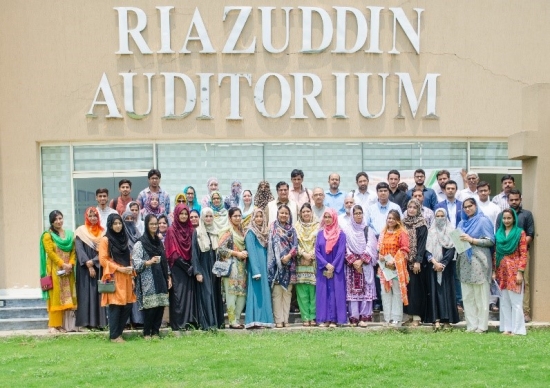
A group photo of participants, organizers and speakers after the successful completion of event (however, most of the participants were left just after the certificate distribution ceremony, so not all are present in this group photo)

Prof. Dr Tayyab Husnain (Director CEMB) is describing the significance of the symposium to a News channel reporter



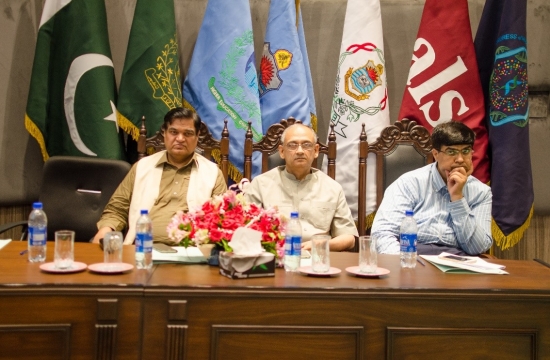



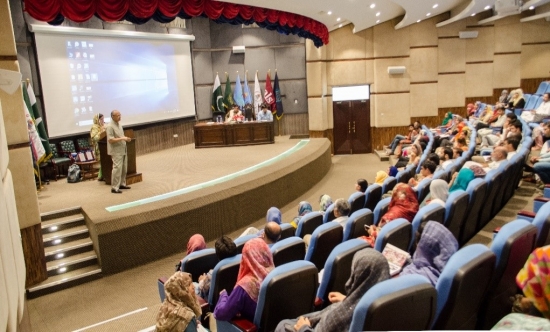


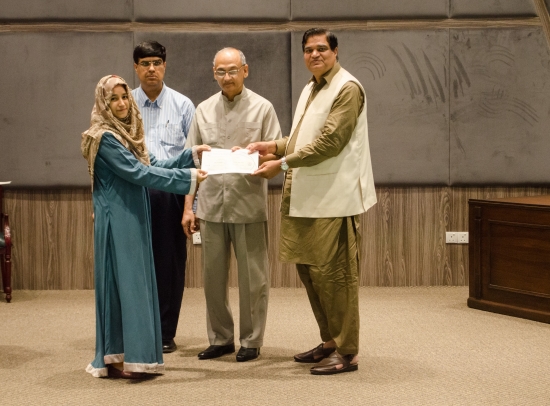
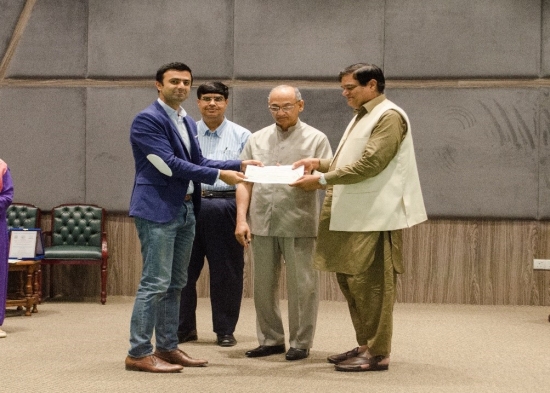

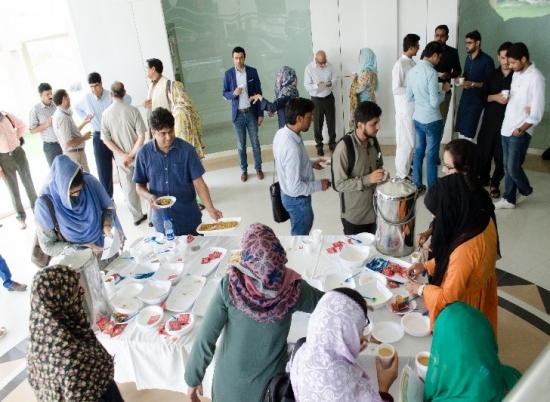
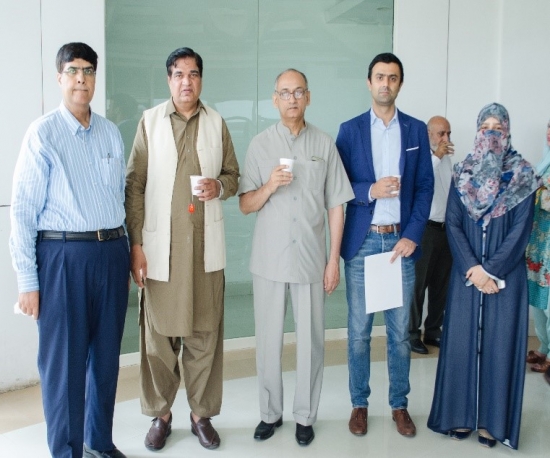


Leave a Reply
Want to join the discussion?Feel free to contribute!